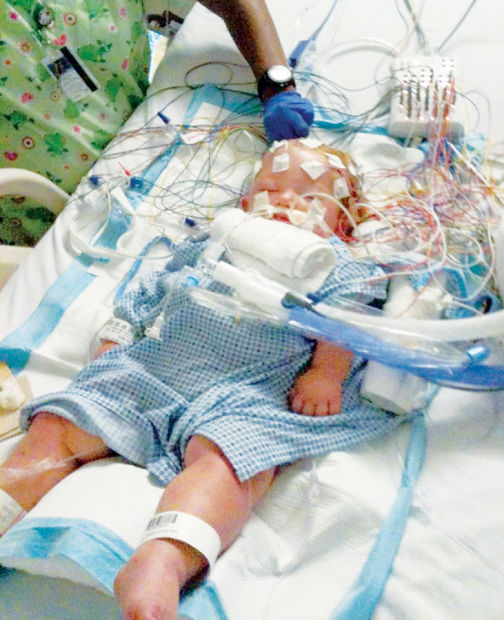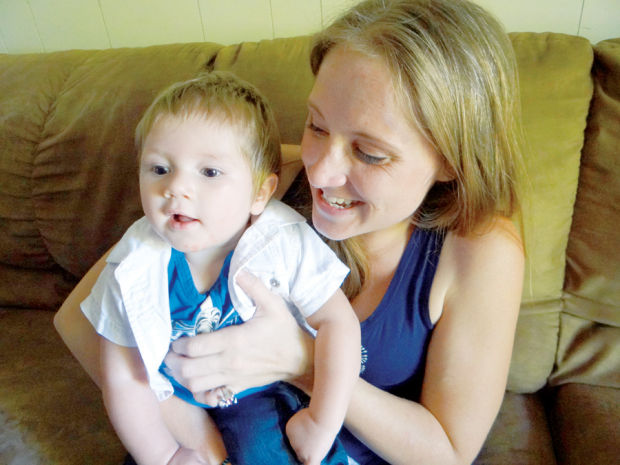KAPAHI — It was a mother’s worst nightmare: Her healthy baby suffers a near fatal injury that will change his life forever. At just 10 months old, Hekili Naea went limp in his day care provider’s arms, before brain swelling
KAPAHI — It was a mother’s worst nightmare: Her healthy baby suffers a near fatal injury that will change his life forever.
At just 10 months old, Hekili Naea went limp in his day care provider’s arms, before brain swelling caused a stroke and the baby was flown to Oahu in a coma. With part of his skull removed, Hekili spent two months in Oahu hospitals and is now blind with permanent brain damage.
“I am just so grateful for him being alive and happy,” said Hekili’s mother, Fawna Kiefer. “He was a healthy boy and pretty outgoing, almost walking on his own and saying a couple of words.”
Kiefer, 28, a single mother to a 6-year-old boy, has given up her job to become a full-time caregiver to her 15-month-old disabled son.
“We have a long road ahead of us,” she added.
It was about 11:30 p.m. Oct. 24, 2013, when Kiefer received a call at work. It was an Emergency Medical Technician saying her baby was having a hard time breathing and needed to be incubated.
“I asked the EMT what happened and they said I would have to call the day care provider,” she said.
Kiefer left work and thought she would be taking her baby home or to her doctors at worst. On the way to day care she saw an ambulance with its sirens on and hoped that it was not meant for her baby.
According to Kiefer, the day care provider was not sure what happened, but thought he fell backward and struck his head against a coffee table. She said the baby was crying and then going limp in her arms while sipping on juice. She thought he was choking or seriously ill and called the ambulance when he stopped breathing.
At Wilcox Memorial Hospital, Kiefer said the emergency physicians asked about marks on the baby’s body. She explained the birthmark on his neck, but was not aware of a subdural hematoma just behind his right ear.
The baby’s eyes were dilated differently, one large, and one small, which indicated a head injury, she said. A scan showed there was internal bleeding and hemorrhaging.
Just as doctors decided to medivac the baby to Oahu, he suffered a seizure, she said, due to growing pressure on the brain from swelling.
The doctors sedated the baby to get a breathing tube in and stabilize him for air transport. They decided on Queens Hospital for its top neurology team. At Queens, the doctors worked to reduce the swelling with medication. A hole was drilled in the baby’s skull as a pressure monitor.
Doctors made a reluctant decision to cut open the baby’s skull once Hekili went into cardiac failure for fear the boy would die anyway, she said.
“When he was in surgery, they discovered a large portion of the brain was dead and so they removed it,” she said.
The brain was exposed and covered with a cloth. The piece of skull was put on ice to be replaced surgically in four weeks with hopes that in time it would graft to bone and grow with the skull.
The baby was sedated and on pain killers with a shunt to drain spinal fluid. He could not breathe on his own for a month and his body was not stable enough to regulate body temperature.
Kauai Police Department and Child Protective Services were asking questions about what happened.
“I wasn’t sure on a lot of things and I told them I didn’t know a thing until the ambulance called,” Kiefer said.
As it became more possible it might not have been an accident, Kiefer asked doctors if the injury came from the way he fell, or struck a sensitive spot from a certain angle or location. She said babies bump their heads but this kind of thing doesn’t happen.
The doctors replied that a self-injury in this case did not seem possible, she said.
“The doctors were telling me that it was not physically or humanly possible for someone that size to injure himself in that manner while sitting on the ground and falling backward and hitting their head,” she said. “There was too much trauma and force and they generally only see these kinds of head injuries from car accidents and severe abuse cases.”
The medical incident report from Wilcox indicates suspected abuse with life-threatening injuries. The mother’s name is on the report but the day care center or its owner is not.
The matter has been under investigation by Kauai Police Department and Child Protective Services for nearly five months.
Kiefer said she understands about a pending investigation but is increasingly frustrated at the lack of information. She feels there is more concern for the suspect business than a parent would receive.
“If this had happened to my baby while he was in my care then they would have revoked my custody and I would be in a women’s correctional facility by now,” Kiefer said.
She turned to the Child Protection Services office, the state Attorney General, and the county Office of the Prosecuting Attorney for answers. The wait goes on.
“A criminal case is pending,” said county spokesperson Sarah Blane. “We are unable to comment on any pending litigation.”
After the baby stabilized, he was transferred to a pediatric ICU in the women and children’s hospital for another month. They came home just before Christmas and continue with support from neurologists, occupational and oral speech therapists and the attending physician.
After a glitch where her baby was first said not to be eligible, Kiefer’s case worker got the Social Security system to qualify her son as fully disabled.
“Thank God that Hawaii has the best coverage for children in the United States,” she said. “They upgraded his disability package and all medical coverage including the flights to Oahu are covered.”
Kiefer is on her own with buying home physical therapy equipment and other items that she uses on a daily basis to help her child improve his condition.
“All that kind of stuff is out of pocket,” she said. “I am getting a referral to the Shriners for shoes to help correct his inverted legs.”
The condition has left the baby much more irritable. He must be held constantly and they found that the motion of a swinging baby hammock helps a great deal with vestibular system and balance.
The pressure on the brain was so intense that it caused several strokes, she said. The entire right side of his brain is damaged.
The feeding tube was taken out and Hekili is eating regular food. There is still paralysis on the left side of his face from the stroke but it is improving, she said.
Hekili’s eyes function normally, but the cortical vision impairment is caused by damage to the brain. He can only see shadows at this point, but she hopes the brain will eventually find a way around this problem.
“Because this happened within the first three years of life, when the brain is still developing, there is a good chance that the brain can figure out how to rewire itself moreso than someone who is over age of three,” she said.
Doctors said they expected Hekili would remain a quadriplegic and in a wheelchair for the rest of his life, she said. However, Hekili has bilateral movement in his legs and his arms are also starting to respond to movement — an indication that his brain is connecting with both sides of his body.
“He is not paralyzed and has limited function right now,” Kiefer said. “We have physical and occupational therapy four times a week.”
The part of the brain that was removed provides emotion and humor, she said. The baby still laughs and enjoys things — another sign the brain has somehow rewired itself, she said.
“We have come so far and made huge leaps and bounds,” she said.



